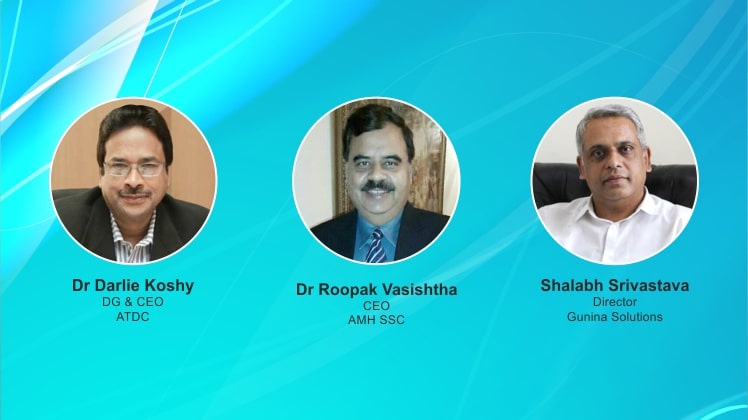The Government is supporting MSMEs (Micro, Small and Medium Enterprises) in various ways, be it changing the definition of MSME or presenting upfront initiatives like setting up the Rs. 20,000 crore subordinate debt for stressed MSMEs and equity infusion of Rs. 50,000 crore through a Fund of Funds. Around 70 per cent of Indian textile and apparel units are in the MSME sector. The Ministry of MSME has also launched initiatives like Entrepreneurship and Skill Development Programmes, Assistance to Training Institutions (ATI), etc. In this scenario, skill development has emerged as a strong support for the MSME sector, as they have limited resources, and thus, need trained workforce to employ. Overall, MSME sector contributes to around 37.54 per cent to the GDP of India and offers employment to 120 million people of the country, and skilling these people is one of the most important aspects for the overall growth of the industries and the country.
During the last few years, India’s initiatives for skill development have played an integral role for various industries, and apparel manufacturing sector has gained a lot from the same. Few such initiatives include the formation of a dedicated Ministry for Skill Development and Entrepreneurship (MSDE), the concept of Sector Skill Councils (SSCs) and the introduction of National Skills Qualification Framework (NSQF). However, somehow the results have not been as per the efforts. The fact of the matter is that the Union as well as the State Governments still continue to work aggressively in this regard. Now when everyone is passing through disruption owing to the COVID-19 pandemic, certain measures need to be focused on to get the maximum benefits for every stakeholder of the industry.
The World Youth Skills Day and the fifth anniversary of ‘Skill India’ mission were celebrated on 15 July. Indian Prime Minister Narendra Modi insisted all to skill, reskill and upskill to remain relevant in the ever-changing market scenario. Mahendra Nath Pandey, Minister of Skill Development and Entrepreneurship, also highlighted that skill development activities will be the backbone of Atmanirbhar Bharat and Garib Kalyan Rozgar Abhiyaan.
All the above-mentioned recent developments and initiatives attract the apparel manufacturing sector also, as it is the highest employment generator that creates maximum jobs under the Pradhan Mantri Kaushal Vikas Yojana (PMKVY), a flagship scheme of the MSDE.
Moving forward, the third phase of the PMKVY is likely to be implemented soon. It will involve industries more and will be highly friendly towards employers. At the same time, the focus will be on latest tech concepts like Industry 4.0. To bring the entire skill ecosystem on a common web portal and work as an aggregator for demand and supply of skilled workforce, the Government is also working on Skill Management Information System.
All this is the need of the hour, as reskilling and multi-skilling are now must for everyone from blue-collar to white-collar workers, as opportunities as well as salaries and wages are less. Even when the conditions will improve, there are thick chances that new working methodologies and work culture are going to dominate. The Indian apparel manufacturing industry is anticipating the lack of proper skilled workforce in future. And so, initiatives for skill development by the Government create a hope for the industry.
But learning from the recent experiences and minutely observing the current unprecedented situation, some specific changes for skill development in the apparel industry are must.
Experts believe that in the garment industry, the automation and non-sewing applications will pick up rapid speed, the labour and supervisory workforce will be rationalised, and the flab and non-value-adding people will be replaced with productive workforce across organisations.
Apparel Training & Design Centre (ATDC) is leading for skills in apparel manufacturing across India with its impressive wide network. Dr. Darlie Koshy, DG & CEO, ATDC, believes that about 30 to 40 per cent of migrant workers will return, but at higher wages. So one of the major challenges is to reskill and upskill them to get them transformed into multi-skilled workers to give them better wages in urban and other manufacturing clusters where they are lured back to work. For doing this, the garment manufacturers need to make more margins, and higher productivity can also lead to higher margins.
Also Read: Sharpening the pencils, better utilisation of time for individual as well as organisation’s growth
As a lot of buzz is already going around skill mapping also, the courses for apparel manufacturing will have to be recalibrated by putting on a scale the level of skill intensity of each course, so that the theoretical contents and skills like digital pattern making which can be taught remotely through online learning and such other courses can be offered on hybrid and online platforms. “The MSDE and National Skill Development Council (NSDC) and State Skill Missions have to accept the realities and change policies. With the contraction of fashion market as predicted by many, the manufacturing will reach a plateau, and hence, the placement benchmark will have to be revised to a maximum of 50 per cent in about 14-15 clusters and in other smaller hubs maybe 35 per cent or so for the next 12-18 months, if skill development programmes have to be realistic,” says Dr. Koshy.
He also insists on following the ‘Go local and Go digital’ strategy going forward. At different levels, the staff and workforce need to acquire completely new skills including soft skills of a higher level, as the competitive dynamics and the consumer predilection are changing and agility and speed to market and direct to consumer will decide the new competitiveness dimensions in global supply chains.
“Both export strategies and skilling strategies will have to be aligned going forward, and a lot more emphasis needs to be given to different levels of RUN (Reskilling, Upskilling and New skilling) at all levels,” he adds.
Here it is pertinent to mention the role of SSCs, as currently 38 SSCs are working under NSDC and MSDE – imparting training to lakhs of youth across the country every year. In the past 6 years, standards of thousands of job roles have been developed by the SSCs which are known as ‘Qualification Packs’.
Right from the setting of standards in each sector, to the formation of protocols related to training and assessments, including training of trainer (TOT) and training of assessor (TOA) are some of the major roles as well as achievements of the SSCs.
Dr. Roopak Vasishtha, CEO, Apparel Made-ups & Home Furnishing Sector Skill Council (AMH SSC), believes that all the developments in the recent years including the formation of SSCs have shown impressive results, as apart from providing skilled workforce in factories, thousands of youth are getting skilled under various job roles such as ‘self-employed tailors’, leading to start their own small units. AMH SSC has created standards for 45 job roles and has certified more than 10,000 trainers and more than 3,000 assessors. It has over 4,500 training partners/centres affiliated to it through which the training is imparted. Till now, more than 12 lakh people have been certified by the AMH SSC, and there is a plan to increase the number so that the industry gets skilled manpower.
“I would urge the industry to start hiring workforce which has been skilled under the ‘Skill India’ mission, so that the system would get further motivated to skill even a larger number of people,” he says.
Apart from Government funded agencies, there are a lot of private organisations in the country that are playing an integral role in working for skill development at various levels. Few of them believe that some relaxations in policies are required for the time being. Shalabh Srivastava, Director, Gunina Solutions, Gurugram, is an expert in skill development for the apparel industry. “Skill initiatives need to reach small villages across the nation. Along with that, policies need to be flexible, so that various schemes can be implemented effectively. It will help to bring fresh but skilled workers in the apparel industry, and it is important as migration has taken place in the recent months,” he shares.
Things are quite positive, and so should be the outcome. But for this, for all the existing and upcoming projects, industry’s need and availability of skilled/unskilled workforce require better coordination with each other and transparency to gain maximum benefits. Just creating huge numbers of skilled workforce and not serving the industry’s purpose will not bring prosperity to the industry or to the workers. Hope all the ‘partners’ in skill development will keep this as their main focus during the implementation of any policy or project.
Also Read: Proper skill mapping can be a game changer for the industry








